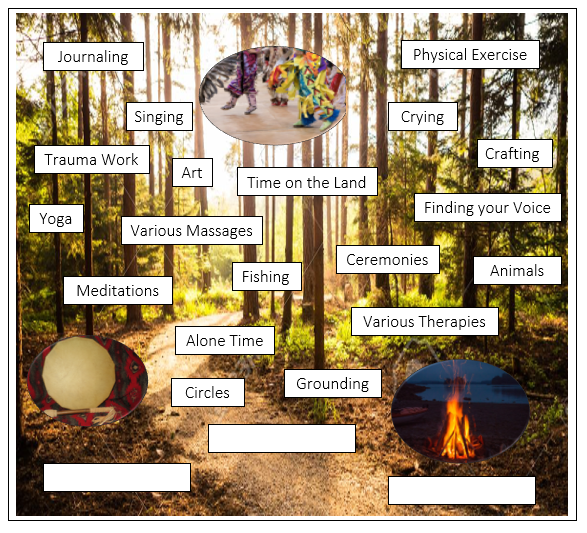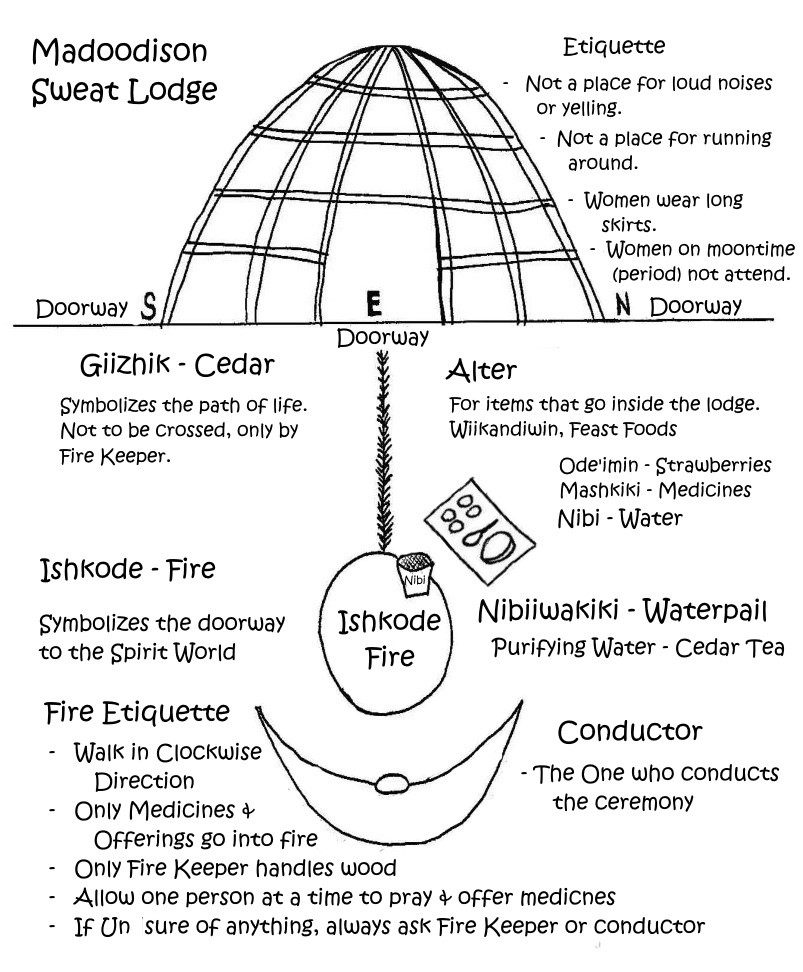12
Learning Objectives
The intention is to review what all has been shared, and to identify what personal tools are in their personal bundle and what can be added.
- Reviewing the concept of a healing journey and to compare with the concept of self care;
- Exploring traditional and contemporary self care and healing practices; and
- Examining personal self care and healing plans.
Filling Your Bundle
Facilitator Tip:
The intention of this section is to explore the difference between self care and healing methods using Anishinaabe culture worldview. This is an opportunity to demonstrate by various energy releasing practices. This will depend on the facilitator’s knowledge and experience.
Self Care vs Healing
| Self Care | Healing |
|---|---|
| The practice of taking an active role in protecting one’s own well-being and happiness, in particular during periods of stress. | The process of the restoration of health from an unbalanced, diseased, damaged or un-vitalized organism. The result of healing can be to cure the cause of a health challenge, but one can grow without being cured or heal without “a cure”. |
| Self Care is Nurturing. | Healing is processing. |
Examples:
|
Examples:
|
Self Care
Self care speaks to how we nurture and feed ourselves in each quadrant of the medicine wheel. It is essential to understand how we communicate with ourselves what our needs are and to identify if they are being met. Review the Human Needs Chart.
Self Reflection
Facilitator Tip:
The last question is meant for the workers to have a change in perception.
Ask the participants how they approach the topic of self care with the people they work with?
Highlight the concepts of Power & Privilege.
Would the community members feel they are being “told” what to do and how to do it, and when they need to do it by?
How do you approach your personal self care?
What helps you with relieving your stress?
Who decides what works for you and what does not?
Healing & Self Care Techniques
What techniques work for you?
|
|
|
What is a Bundle
Based on facilitator’s knowledge and experience can demonstrate and share personal experiences about:
- Medicine’s & Healing Ceremonies
- Releasing Ceremonies
The intention is to explain the various ceremonies that may be requested, so that the workers have a basic understanding.
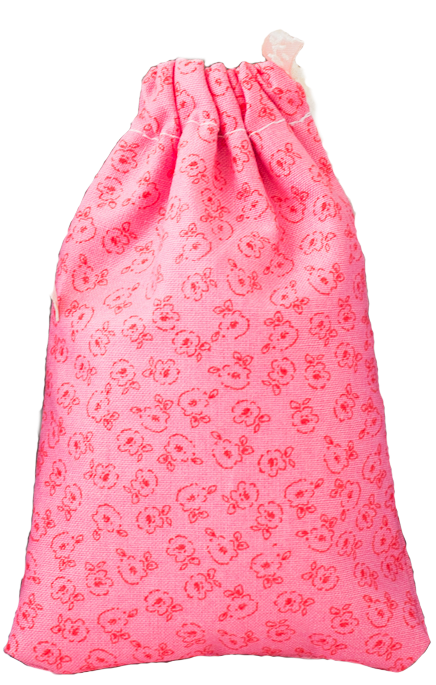 A “bundle” is a collection of both physical and metaphorical tools for a person’s wellbeing. It is customary for a bundle to comprise of items and endowments that are gifted. Each gift has a story, and symbolizes a lesson, a teaching and/or growth from an experience which a person earns. These endowments are to be fasted and feasted.
A “bundle” is a collection of both physical and metaphorical tools for a person’s wellbeing. It is customary for a bundle to comprise of items and endowments that are gifted. Each gift has a story, and symbolizes a lesson, a teaching and/or growth from an experience which a person earns. These endowments are to be fasted and feasted.
Example, at a past Nogdawindamin language camp 2 workers volunteered their time to help the Cultural Services team (back when the team was a small handful of people). They devoted their time and energy over the 3 days without question or complaints. These 2 individuals repeatedly volunteered with various events over the years. An elder decided that he wanted to acknowledge these 2 men by gifting them eagle feathers for their dedication, commitment and giving of their hearts. The Cultural Services team presented dressed feathers with cases to these men in ceremony. They earned these feathers by giving of themselves for the people. One of the greatest honours is to be gifted an eagle feather.
Personal Smudge Bundle
A personal Smudge Bundle is gifted to each employee to assist with their development and stress management. Development refers to their personal healing journey with the difficult work with the social service field. This bundle is for personal use only, and not to be used with community members (clients). Members from Cultural Services will work with traditional medicines and families.
Smudging is for the purification; the medicines are put into a smudge bowl/pan and lit on fire so that it smolders and produces smoke. It is with this smoke that is used to bathe the body and to clear negative energies. Before starting, it is customary to speak to the medicines with your intention.
The Four Main Mishkiki (Medicines)
By Mike Bisson
Asemaa (Tobacco)
A medicine from the creation story, to be used as an asemaake (offering) in reciprocation when addressing Gitchie Manidoo (Creator and the Spirit World). This is the first medicine used above all. The act of giving and not just taking. This is why it is so important to present tobacco when requesting anything.
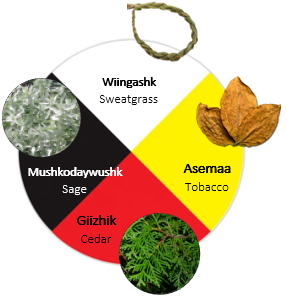 When presenting tobacco, it can be loose or in a tobacco tie.
When presenting tobacco, it can be loose or in a tobacco tie.
Giizhik (Cedar)
Is very important to the Anishinaabe in this geographical area, it is a medicine for protection and is used for its strength. An example is a deer eats it in wintertime to help it through the hardship of winter. Traditionally cedar is used to give first baths when babies come into this world, and as a last bath as a person leaves. Today, it is more commonly used in ceremony to help with grief and trauma.
Cedar has properties to create a space that clears negative energy and is used for protection against it. It is used in majority of ceremonies, and for some it is the main component that is used to dress the ceremonial area. Traditionally, Cedar is the medicine that was used to smudge.
Mushkodaywushk (Sage)
Is the first medicine used as smudge to cleanse space. At gatherings and ceremonies, it is used to cleanse the space. It is brought around to the people to help the mind to have good thoughts and release negativity, and to prepare for ceremony what they are to do and what they are about to receive.
Traditionally in this geographical area, the prairie sage or buffalo sage does not grow naturally. Rosemary sage/Pearly Everlast was used by women.
Wiingashk (Sweatgrass)
Is known as grandmothers’ hair and is commonly seen as a braid as it is a binding plant. Each strand represents mind, body and spirit. When smoldering, the smoke is gentle and reminds us to be humble, kind and gentle with our actions and words.
Sweetgrass braids are commonly put into vehicles for protection of safe travels. It is also made into beautiful artwork of basket making.
The Four Main Mishkiki (Medicines) by Mike Bisson Handout PDF
 Smudge bowls – quahog shells and abalone shells are used as smudge bowls, these represent the water world. To encourage the sustainability of these organisms, cast iron pots are now commonly used.
Smudge bowls – quahog shells and abalone shells are used as smudge bowls, these represent the water world. To encourage the sustainability of these organisms, cast iron pots are now commonly used.
A bundle is personal and individual, no bundle is the same.
Food as Medicine – Journey of the Seed
Having a holistic perspective of wellness is also to be conscious of what we put into and around our bodies. This includes food, fluids, other substances and energy. Another way of looking at this is to think of how we nurture our environment and ourselves. A good example is going back to the tree analogy. What are we putting into the soil?
How we nurture and feed our bodies has direct impact and effects on a person’s energy levels. If a person’s energy levels are down, and they are in a negative environment, plus they are eating empty calories; of course, they will be unstable, not able to think solidly, and probably moody. It is recommended to pay attention or ask question with a person’s eating habits. Things to pay attention to are:
- What are they eating?
- How are they eating?
- Stress eating
- Binge eating
- Any fruits and vegetables or greens?
Today diabetes is an epidemic in Indigenous communities, it has devastating effects on a person’s physical, mental, emotional and spiritual levels. As mentioned, if a person is unstable, had empty calories, and no fluids they will more than likely be moody. This may have an impact with how a community member is going to receive you.
It is recommended to bring natural snacks to a visit to encourage healthy eating. On visits, try to bring:
- Bottle of water
- Berries or fruit for the children
- Do not bring high sugar snacks ie: bearpaws.
To take it a step further, try to arrange visits and circles at a natural space on the land. This could be Nogdawindamin Tipi’s, Community Tipi’s, pow wow ground arbours, parks etc. This would assist with taking the power out of the equation.
Releasing Ceremonies
Releasing ceremonies are unique to each individual Nations. The built up of Energy (past and present) can become attached to individuals and families. Releasing ceremonies help to cleanse individuals from negative energies, and pent up emotions that are held with in the body. Some examples but not all include:
- Cedar Bath – See Cedar above
- Sweatlodge – Will discuss in more detail on Friday
- Eagle Fan – An eagle fan is used to wipe off negative energies by an experienced traditional Practioner.
Fasting
This ceremony has been practiced by Anishinaabe for thousands of years. Fasting is a personal experience with purpose and is between that individual and creator. Fasting is abstaining from food and water while spending time on the land and in creation. This time can range between 1 day to 4 days & nights and possibly more depending on vision and direction. The purpose of fasting is to deprive the body of food and water for clarity of the mind to receive visions, and for connection to one’s spirit and spirit helpers.
It is common for a sacred fire to be lit for fasters that have been put out, supporters are welcome to come to the fire and offer their prayers.
Modoodison, the Sweat Lodge
Introduction to Sweat Lodge Teachings, a Background
Where the madoodison (sweat lodge) originate?
Each First Nation has their own story/legend of how the sweat lodge came to their people. This is the story of how the sweat lodge was brought to the Anishinaabe people, told by Edward Benton-Banai from The Mishomis Book.
The little boy that had travelled to the lodge of the Seven Grandfathers brought back a gift to the people. The gift is for the people seeking guidance and direction by a vision quest, through fasting. Fasting is a time when the body (vessel) goes without food and water. It is thought that when the physical body (vessel) is weakened, that makes the spiritual side stronger. It is said that fasting purifies the body and mind and makes it easier and more receptive for messages to come from the spirit world.
When a child approaches adulthood and begins the signs of puberty; that signals it is time for the young person’s puberty fast, their first vision quest.
Long ago, there was a young man known as “the little boy” that went on his puberty fast, and was taken to the star world, and brought through the four layers that surrounded earth. He journeyed through the part of the crescent moon we do not see but know is there. The little boy was taken to the lodge of the Seven Grandfathers, it was there that he was showed a healing ceremony to bring back to the people that will help with purification of the body and mind.
The ceremony is thought of as going into the womb of your mother and having the cleansing power of cedar tea and the heat of the grandfather rocks that produce a steam. The ceremony is lead by an experienced conductor that has the knowledge to journey to the spirit world and request the help of the ancestors, through prayer, songs and medicine. Each direction and level are honoured and acknowledged, symbolized in what is known as a “round’. When it is time to exit the lodge, the people humbly crawl out; it is compared to being reborn. Some people will stand and call out in appreciation to symbolize their reunification of their spirit and vessel. This ceremony is known to the Anishinaabe people as madoodison (the Sweat lodge).
The Sweat Lodge Protocols – outside
Sweat lodge Protocol – inside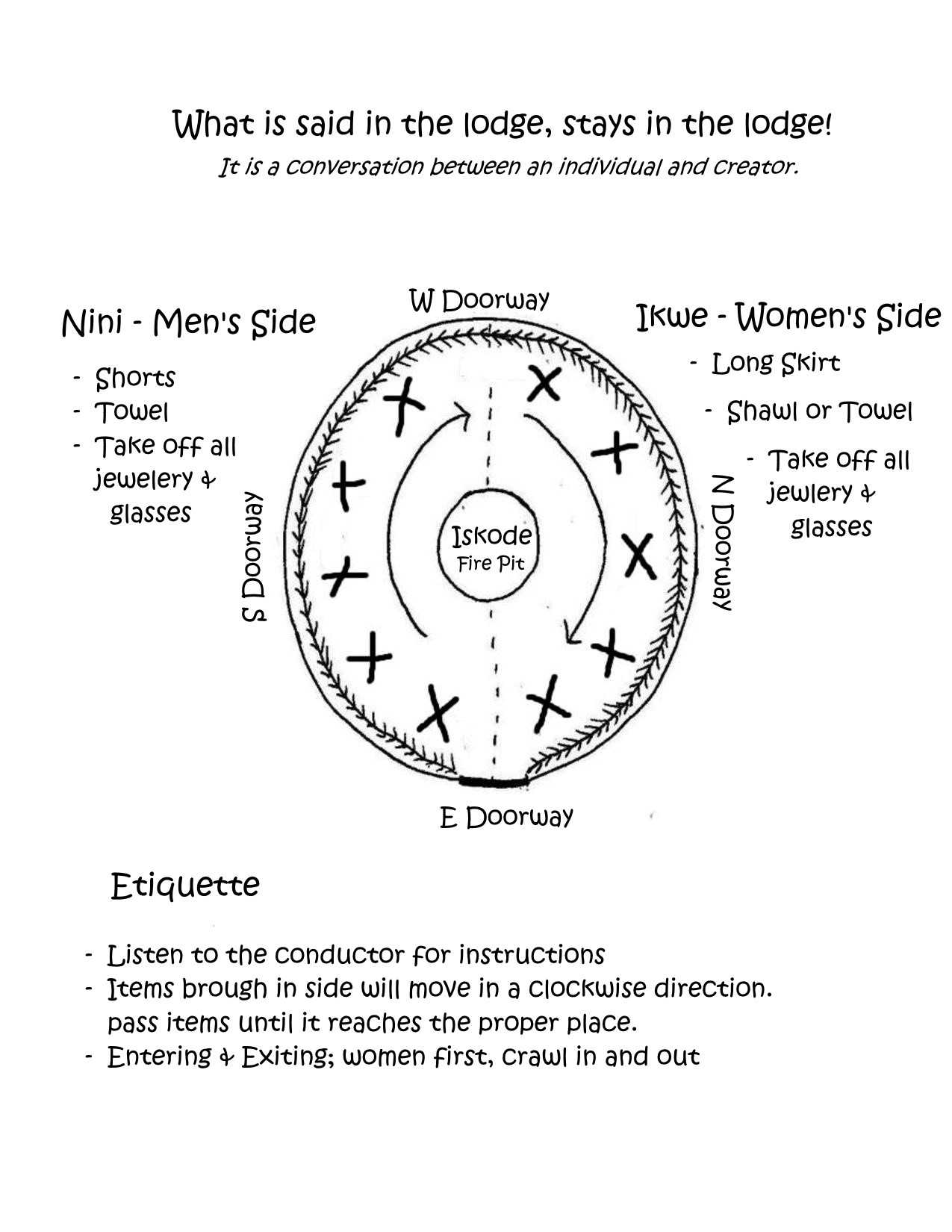 Anishinaabemowin
Anishinaabemowin
| English | Anishinaabemowin | Syllabics |
| Sweat lodge | Madoodison | Ma-do-do-swun |
| Vision | Bawaajigan | Ba-wa’-ji-gay’-win |
| Star world | Anangokaa | Ah-nung’go-kwan |
| Pathway | Miikana | Me-ka-naynz’ |
| Cedar | Giizhikaatig | Gee-zhee-kan’-dug |
| Fire | Ishkode | Ish-ko-day |
Feast Bundle
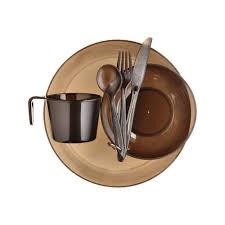 A feast bundle consists of your own dish/bowl/cup/cutlery. Some people have bags that they keep it in and only use for feasts or ceremony. If you are new to this custom, you can take some dishes from your cupboard. I personally like having a bowl with a tight-fitting lid to bring some home.
A feast bundle consists of your own dish/bowl/cup/cutlery. Some people have bags that they keep it in and only use for feasts or ceremony. If you are new to this custom, you can take some dishes from your cupboard. I personally like having a bowl with a tight-fitting lid to bring some home.
“when you treat your plate and utensils like a scared item, then the food you put in your body becomes sacred.”
- Other Benefits:
- Environmentally Consciences
- Be apart of the solution, not the problem
Self Reflection
Go back to how you originally defined a healing journey, would you change or add anything?
Summary
Connection is what brings people together and is the key element to relationship building.
Tips to be conscious of when interacting with community (internal to Nogdawindamin, clients, and First Nation workers):
- Ground Self, before any type of meeting
- Be Authentic, tell a little about yourself (remembering your 4P’s)
-
- Remove any power & privilege
- Whenever possible bring to the land, it removes power
3. Ask if the community member would like to start with a prayer (depending on situation).
4. Be conscious of families and individuals beliefs.
5. Allow vulnerability (listen to the stories)
-
- Focus on communication and establishing relationships.
- Validate what the community member shares
A reminder to be conscious of removing power & privilege in the relationship. This could mean, bringing visits to safe spaces on the land, near water or by a fire. When visits are taken out of the home and office, the preconception of power and judgement is not as strong.
Key Takeaways
- Understanding the importance of self care and personal identification of difference between healthy self care and unhealthy distractions.
- An introduction to Anishinaabe releasing ceremonies.
Media Attributions
- Healing n Self Care Techniques
- Bundle image
- Four Medicine image
- Smudge Bowl
- Sweatlodge Protocol_outside
- Sweatlodge Protocol_inside
- feast bundle
